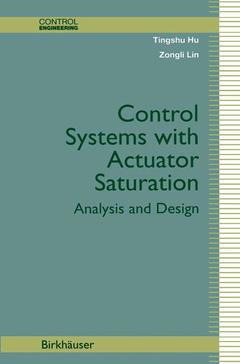Description
Control Systems with Actuator Saturation, Softcover reprint of the original 1st ed. 2001
Analysis and Design
Control Engineering Series
Authors: Hu Tingshu, Lin Zongli
Language: English
Keywords
Actuator saturation; Control Engineering; Linear Systems; Sensor; actuator; calculus; reading; complexity
Control Systems with Actuator Saturation
Publication date: 10-2012
392 p. · 15.5x23.5 cm · Paperback
Publication date: 10-2012
392 p. · 15.5x23.5 cm · Paperback
105.49 €
Subject to availability at the publisher.
Add to cart
Control systems with actuator saturation. Analysis and design
Publication date: 06-2001
Support: Print on demand
Publication date: 06-2001
Support: Print on demand
Description
/li>Contents
/li>
Saturation nonlinearities are ubiquitous in engineering systems. In control systems, every physical actuator or sensor is subject to saturation owing to its maximum and minimum limits. A digital filter is subject to saturation if it is implemented in a finite word length format. Saturation nonlinearities are also purposely introduced into engineering systems such as control sys tems and neural network systems. Regardless of how saturation arises, the analysis and design of a system that contains saturation nonlinearities is an important problem. Not only is this problem theoretically challenging, but it is also practically imperative. This book intends to study control systems with actuator saturation in a systematic way. It will also present some related results on systems with state saturation or sensor saturation. Roughly speaking, there are two strategies for dealing with actuator sat uration. The first strategy is to neglect the saturation in the first stage of the control design process, and then to add some problem-specific schemes to deal with the adverse effects caused by saturation. These schemes, known as anti-windup schemes, are typically introduced using ad hoc modifications and extensive simulations. The basic idea behind these schemes is to intro duce additional feedbacks in such a way that the actuator stays properly within its limits. Most of these schemes lead to improved performance but poorly understood stability properties.
Preface.- 1 Introduction.- 1.1 Linear Systems with Actuator Saturation.- 1.2 Notation, Acronyms, and Terminology.- 2 Null Controllability–Continuous-Time Systems.- 2.1 Introduction.- 2.2 Preliminaries and Definitions.- 2.3 General Description of Null Controllable Region.- 2.4 Systems with Only Real Eigenvalues.- 2.5 Systems with Complex Eigenvalues.- 2.6 Some Remarks on the Description of C(T).- 2.7 Asymptotically Null Controllable Region.- 2.8 Conclusions.- 3 Null Controllability–Discrete-Time Systems.- 3.1 Introduction.- 3.2 Preliminaries and Definitions.- 3.3 General Description of Null Controllable Region.- 3.4 Systems with Only Real Eigenvalues.- 3.5 Systems with Complex Eigenvalues.- 3.6 An Example.- 3.7 Asymptotically Null Controllable Region.- 3.8 Conclusions.- 4 Stabilization on Null Controllable Region -Continuous-Time Systems.- 4.1 Introduction.- 4.2 Domain of Attraction-Planar System under Saturated Linear Feedback.- 4.3 Semi-Global Stabilization-Planar Systems.- 4.4 Semi-Global Stabilization-Higher Order Systems.- 4.5 Conclusions.- 5 Stabilization on Null Controllable Region-Discrete-Time Systems.- 5.1 Introduction.- 5.2 Global Stabilization at Set of Equilibria-Planar Systems.- 5.3 Global Stabilization-Planar Systems.- 5.4 Semi-Global Stabilization-Planar Systems.- 5.5 Semi-Global Stabilization-Higher Order Systems.- 5.6 Conclusions.- 6 Practical Stabilization on Null Controllable Region.- 6.1 Introduction.- 6.2 Problem Statement and Main Results.- 6.3 Proof of Main Results.- 6.4 An Example.- 6.5 Conclusions.- 6.A Proof of Lemma 6 3 1.- 6.B Proof of Lemma 6 3 2.- 7 Estimation of the Domain of Attraction under Saturated Linear Feedback.- 7.1 Introduction.- 7.2 A Measure of Set Size.- 7.3 Some Facts about Convex Hulls.- 7.4 Continuous-Time Systems underState Feedback.- 7.5 Discrete-Time Systems under State Feedback.- 7.6 Extension to Output Feedback.- 7.7 Conclusions.- 8 On Enlarging the Domain of Attraction.- 8.1 Introduction.- 8.2 Continuous-Time Systems.- 8.3 Discrete-Time Systems.- 8.4 Conclusions.- 9 Semi-Global Stabilization with Guaranteed Regional Performance.- 9.1 Introduction.- 9.2 Expansion of the Domain of Attraction.- 9.3 Semi-Globalization–Discrete-Time Systems.- 9.4 Semi-Globalization – Continuous-Time Systems.- 9.5 An Example.- 9.6 Conclusions.- 10 Disturbance Rejection with Stability.- 10.1 Introduction.- 10.2 Continuous-Time Systems.- 10.3 Discrete-Time Systems.- 10.4 Conclusions.- 11 On Maximizing the Convergence Rate.- 11.1 Introduction.- 11.2 Continuous-Time Systems.- 11.3 Discrete-Time Systems.- 11.4 Conclusions.- 12 Output Regulation–Continuous-Time Systems.- 12.1 Introduction.- 12.2 Preliminaries and Problem Statement.- 12.3 The Regulatable Region.- 12.4 State Feedback Controllers.- 12.5 Error Feedback Controllers.- 12.6 An Example.- 12.7 Conclusions.- 13 Output Regulation–Discrete-Time Systems.- 13.1 Introduction.- 13.2 Preliminaries and Problem Statement.- 13.3 The Regulatable Region.- 13.4 State Feedback Controllers.- 13.5 Error Feedback Controllers.- 13.6 Conclusions.- 14 Linear Systems with Non-Actuator Saturation.- 14.1 Introduction.- 14.2 Planar Linear Systems under State Saturation-Continuous-Time Systems.- 14.3 Planar Linear Systems under State Saturation-Discrete-Time Systems.- 14.4 Semi-Global Stabilization of Linear Systems Subject to Sensor Saturation.- 14.5 Conclusions.
© 2024 LAVOISIER S.A.S.
These books may interest you

Saturated Switching Systems 105.49 €



